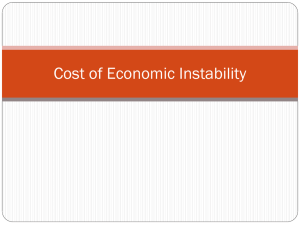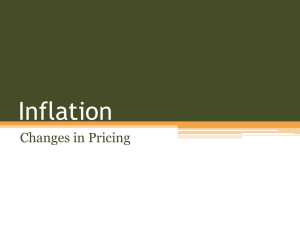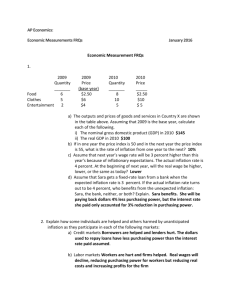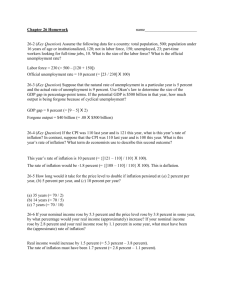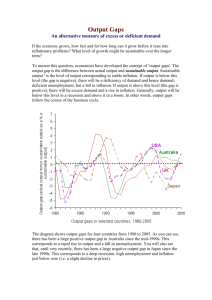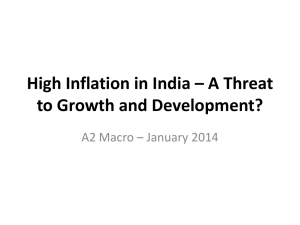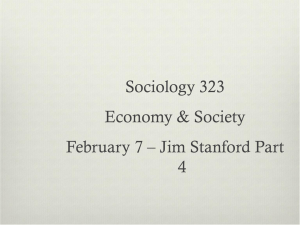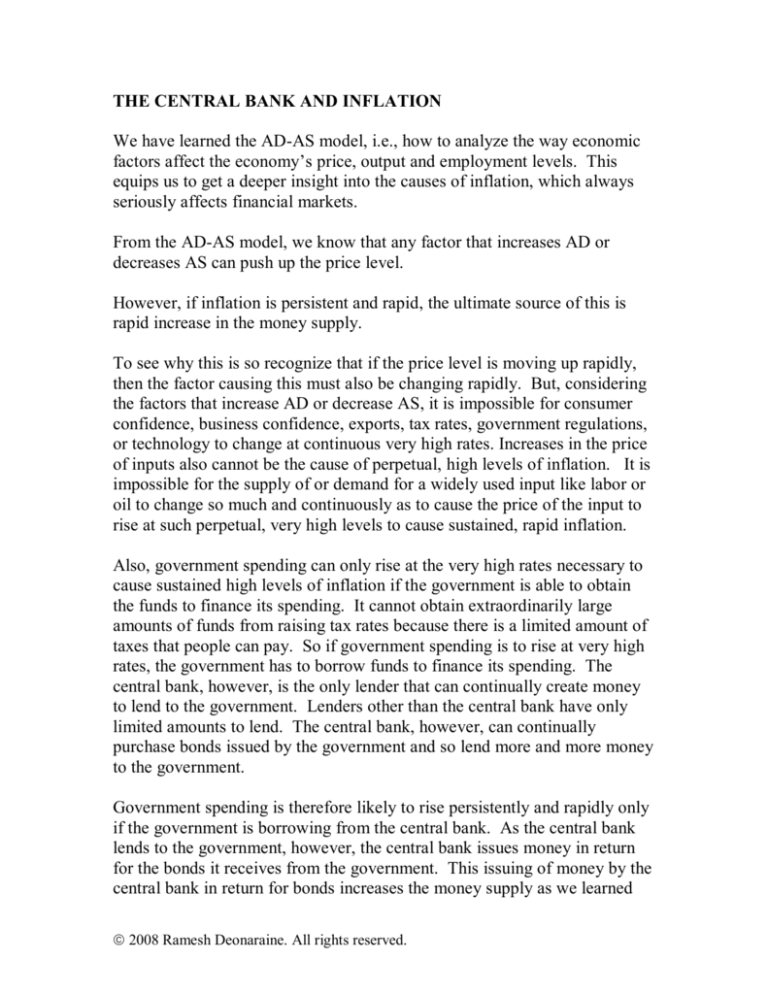
THE CENTRAL BANK AND INFLATION
We have learned the AD-AS model, i.e., how to analyze the way economic
factors affect the economy’s price, output and employment levels. This
equips us to get a deeper insight into the causes of inflation, which always
seriously affects financial markets.
From the AD-AS model, we know that any factor that increases AD or
decreases AS can push up the price level.
However, if inflation is persistent and rapid, the ultimate source of this is
rapid increase in the money supply.
To see why this is so recognize that if the price level is moving up rapidly,
then the factor causing this must also be changing rapidly. But, considering
the factors that increase AD or decrease AS, it is impossible for consumer
confidence, business confidence, exports, tax rates, government regulations,
or technology to change at continuous very high rates. Increases in the price
of inputs also cannot be the cause of perpetual, high levels of inflation. It is
impossible for the supply of or demand for a widely used input like labor or
oil to change so much and continuously as to cause the price of the input to
rise at such perpetual, very high levels to cause sustained, rapid inflation.
Also, government spending can only rise at the very high rates necessary to
cause sustained high levels of inflation if the government is able to obtain
the funds to finance its spending. It cannot obtain extraordinarily large
amounts of funds from raising tax rates because there is a limited amount of
taxes that people can pay. So if government spending is to rise at very high
rates, the government has to borrow funds to finance its spending. The
central bank, however, is the only lender that can continually create money
to lend to the government. Lenders other than the central bank have only
limited amounts to lend. The central bank, however, can continually
purchase bonds issued by the government and so lend more and more money
to the government.
Government spending is therefore likely to rise persistently and rapidly only
if the government is borrowing from the central bank. As the central bank
lends to the government, however, the central bank issues money in return
for the bonds it receives from the government. This issuing of money by the
central bank in return for bonds increases the money supply as we learned
2008 Ramesh Deonaraine. All rights reserved.
earlier in this training. As the government continually borrows large sums
from the central bank, the money supply increases sharply causing very high
levels of inflation.
Rapid increase in the money supply is therefore the ultimate cause of
persistent, rapid inflation. Any factor that increases AD or decreases AS can
cause inflation, but persistent, high levels of inflation is caused by rapid
increase in the money supply. To deal with such inflation, therefore, there is
only one remedy—the growth of the money supply must be reduced.
The Equation of Exchange
The equation of exchange, which we will now learn, gives us further insights
into the role of money in causing inflation.
Suppose in 2007 the total amount of purchases (or sales) in an economy was
$500 million, and the money stock was $100 million. Then on the average
each dollar of the money stock was used 500/100 = 5 times in paying for the
transactions during 2007.
As money moves from person to person when purchases and sales occur, the
same currency note gets used many times in making payments. For
example, if I pay you $5 for a good I purchase from you, you may then use
these $5 to pay for your purchases from another person, who then uses them
to pay another person. The same $5 are used 3 times in making these
transactions, so on the average each dollar of these 5 is used 3 times in
making payments.
The average number of times each dollar of the money stock is used in
paying for transactions is called the velocity of circulation of money, or just
velocity of circulation or velocity for short.
If, in a given time period in an economy, Q is the total amount of goods and
services bought or sold and P is the average price level, then the dollar value
of transactions equals PQ. If M is the money stock, then the velocity of
circulation is PQ/M. Therefore, MV = PQ.
2008 Ramesh Deonaraine. All rights reserved.
In calculations of V, nominal GDP is generally used as an approximation for
PQ, which would mean Q is approximated by real GDP. This happens
because GDP figures are readily available in statistical sources.
MV = PQ, or MV = Nominal GDP, or MV = P times real GDP, is called the
equation of exchange.
This equation can be used to examine the role of money in causing inflation.
By simple mathematical manipulation, the equation of exchange, MV = P
times real GDP, can be re-expressed as:
Inflation rate = Growth rate of the money stock
+ Growth rate of velocity
- Growth rate of real output
(Take logs of MV=PQ, differentiate with respect to time and rearrange
terms.)
This formula shows that declining growth of output, increasing growth of
the money stock, and increasing growth of velocity result in rising inflation.
But it is impossible for output growth to decline at continuous, very high
levels. So very high and rising levels of inflation cannot be due to declining
output growth. Of the two other possible causes of inflation, growth of the
money stock and growth of velocity, it is rapid growth of the money stock
that causes very rapid rates of inflation. In fact, as the money stock grows
rapidly and speeds up inflation, this causes people to want to get rid of
money very quickly by buying goods and services. This is what will
increase velocity—which measures the average number of times each dollar
of the money stock is used in making payments. So it is large increases in
the money stock that is the ultimate cause of very high levels of inflation.
If you became a political leader and you were inclined to have your
government borrow from the central bank to finance very large increases in
spending, bear in mind that the central bank by issuing money increases the
money stock. If these increases in the money stock occur in very large and
rising amounts, this will cause high levels of inflation, even hyperinflation.
If, after taking this seminar, you know this lesson alone you will be wiser
than many political leaders the world has very painfully endured.
2008 Ramesh Deonaraine. All rights reserved.
The notion of how the economy is affected by money that is embodied in the
equation of exchange is known at the quantity theory of money—how the
quantity of money in the economy ultimately affects prices.
Central Bank Irresponsibility and Hyperinflation
Various countries have suffered from prolonged bouts of hyperinflation as a
result of their central bank engaging in massive money creation to lend to
their governments, as just described above. Earlier in this training, we
described some of the horrors of hyperinflation. In all of these cases of
hyperinflation, inflation came under control when the central bank ceased its
excessive money creation.
2008 Ramesh Deonaraine. All rights reserved.



